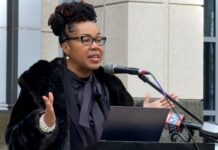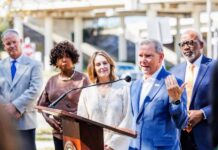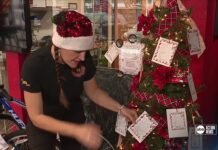Roughly six million adults in the U.S. identify as Afro-Latino, which means they are people who are of African descent with roots in Mexico, Central and South America and the Caribbean — and the U.S. by extension.
“…The reality is that the term is not universally accepted and there is no consensus about what it means. The difficulties surrounding what we call ourselves reflect the complex histories of Africans and their descendants in the Americas,” reads an excerpt from “The Afro-Latin@ Reader: History and Culture in the United States” by Miriam Jiménez Román.
As education surrounding Latino identity grows and expands, specifically recognizing the presence of Black Latinos in the U.S., there have been calls for more expansive curriculums that address such histories throughout the Americas, including the colonial origins of Latino and Hispanic ethnic labels. In recent years, museums have hosted exhibits that examine Afrolatinidad and cultural experiences of Afro-Latinx communities.

“afroLAtinidad: mi casa, my city” opened in 2021 during Black History Month at LA Plaza de Cultura y Artes and also featured a 3D Virtual tour of the exhibit. The exhibit is a recreation of an “Afro-Latinx home” and demonstrates “how this vibrant yet underrepresented community is central to Los Angeles culture” (LA Plaza de Cultura y Artes).
Contributing to the growing number of exhibitions is an upcoming exhibit called Afróntalo that will be hosted by the California State University, San Bernardino (CSUSB) Anthropology Museum. The exhibit is expected to launch in September 2023 and will “explore the history, heritage and experiences of Afrolatine communities, with a focus on Afro-Mexico.”
Arianna Huhn, sociocultural anthropologist professor at CSUSB and the director of the Anthropology Museum, explained that the term “Afrolatine” — pronounced Afro-latin-ay — is used to refer to Afro-descendants who have heritage ties in Latin America and/or the Caribbean. The phrase is used in lieu of Afro-Latino, which emphasizes gender binaries, and Afrolatin@, which is historically associated with “cisgendered 1990s feminism.” Across the U.S., Afro-Latinx has been recognized as a more inclusive term that removes gender pronouns, but some surveys have found that the term is used infrequently.
“Some people really prefer just to be called Black Hispanic. Some people prefer to be called a term or identify themselves with a term that is more specific to their national origins like Black Panamanian. Some people just didn’t identify with the term Latinx,” Huhn said as she described the feedback from interviews she conducted for the exhibit.
The idea behind the Afróntalo exhibit started with Huhn participating in the Fulbright-Hays Seminar abroad program called “The Third Root: Exploring African Heritage in Mexico” in 2021. With her background in African Studies and Museum Studies, Huhn worked alongside local organizations based in southern California such as the International Society of Black Latinos and the Afro-Latinx Connections Club, a student club at the University of California, Los Angeles to plan, design and develop the components of the exhibit.
“The project really has these two main dimensions within the exhibition itself. One is really a focus on Afro descendants in Mexico, and the other is a focus on [Afrolatines],” Huhn explained. “In California, when we first started the project, we were really focused on the Inland Empire, but it’s grown to kind of mainly southern California, but also California as a whole and thinking about the Afrolatines in our states.”
Initially proposed as a small exhibit, Huhn said she was “taken aback” by everything she learned, how rich the cultures were in Mexico and inspired by the activists in Mexico who were adamant about telling their own stories.

What Afro-Latinos Want You to Know. (source: youtube.com).
Huhn decided to create a broader exhibition that will support communities telling their own stories about their experiences and cultural practices in the U.S. Utilizing social media and word of mouth, Huhn worked with three undergraduate students to conduct interviews with people who identify as Afrolatine. The team recruited 20 individuals across roughly 10 Latin American countries, including the Caribbean, who will be featured in the exhibit as narrators.
Roughly 52% of the population in Riverside County identifies as Hispanic and about 56% of the population in San Bernardino County identifies as Hispanic. With a large Hispanic population in the Inland Empire, Huhn explained that this exhibit will be important for the community to learn more about Blackness in Latin America, especially with respect to Afro-Mexicans in the region and Afrolatine communities in the U.S., who are often left out of conversations in Latin America.
“In much of Latin America, Blackness has been erased — has been degraded. And not only there, but of course, we’re living in a world where there’s dominant, predominant, anti-Blackness in so many different spaces,” Huhn stated. “I think this exhibition is really important in order to kind of place a discussion about Blackness in Latin America within these broader discussions about anti-Blackness and demands for monoethnicity in association with authenticity.”
The museum recently received a grant from the Institute of Museum and Library Services (IMLS) that will fund the search for Afrolatine artists in California to create portraits of participants interviewed for the exhibit.
The post The Vibrant Yet Underrepresented Afro Latino Community appeared first on Black Voice News.
The post The Vibrant Yet Underrepresented Afro Latino Community first appeared on BlackPressUSA.














